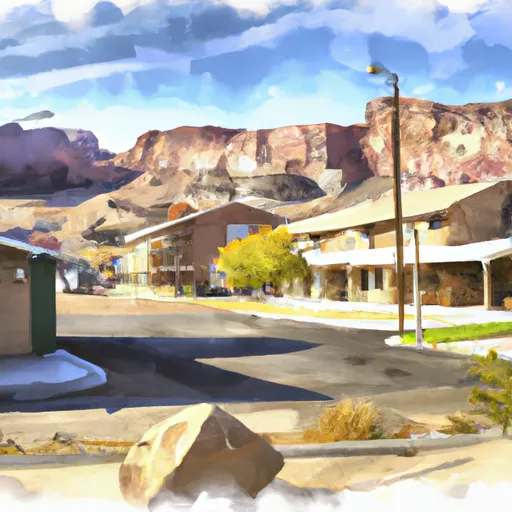-
 Snoflo Premium
Snoflo Premium
Get unlimited access to all our content
With no Ad interruptions! - Start Your Free Trial Login with existing account
Marble-Canyon
Eden Index
Climate
8.3
•
Recreation
2.5
•
Community
•
Safeguard
4.2/10

Marble Canyon, located in northern Arizona, offers a breathtaking landscape and a variety of outdoor recreation opportunities. The area experiences a semi-arid climate, characterized by hot summers and mild winters. Summers can be extremely hot, with temperatures often exceeding 100°F, while winters are cool, with temperatures ranging from 30°F to 50°F.
Hydrologically, Marble Canyon is renowned for its magnificent Colorado River, which cuts through the canyon, creating stunning rock formations and picturesque views. The river's turquoise waters attract outdoor enthusiasts for activities like rafting, kayaking, and fishing. Many visitors also explore the nearby Lees Ferry, where the Paria River meets the Colorado River, offering additional recreational opportunities.
Marble Canyon offers numerous outdoor recreation activities, allowing visitors to immerse themselves in nature. Hiking trails, such as the Marble Canyon Rim Trail, provide stunning views of the canyon and its surrounding cliffs. Wildlife viewing is also popular, with opportunities to spot bighorn sheep, eagles, and other native species.
Whether you seek thrilling water adventures, breathtaking hikes, or simply a peaceful retreat in nature, Marble Canyon promises an unforgettable experience in the heart of Arizona's stunning landscape.
What is the Eden Index?
The Snoflo Eden Index serves as a comprehensive rating system for regions, evaluating their desirability through a holistic assessment of climate health, outdoor recreation opportunities, and natural disaster risk, acknowledging the profound impact of these factors on livability and well-being.
Climate Health Indicator (CHI): 8.3
Marble-Canyon receives approximately
220mm of rain per year,
with humidity levels near 36%
and air temperatures averaging around
15°C.
Marble-Canyon has a plant hardyness factor of
8, meaning
plants and agriculture in this region tend to thrive here all year round.
By considering the ideal temperature range, reliable water supplies, clean air, and stable seasonal rain or snowpacks, the Climate Health Indicator (CHI) underscores the significance of a healthy climate as the foundation for quality living.
A healthy climate is paramount for ensuring a high quality of life and livability in a region, fostering both physical well-being and environmental harmony. This can be characterized by ideal temperatures, reliable access to water supplies, clean air, and consistent seasonal rain or snowpacks.
Weather Forecast
Streamflow Conditions
Lower Colorado-Lake Mead
Area Rivers
Lower Colorado-Lake Mead
Snowpack Depths
Lower Colorado-Lake Mead
Reservoir Storage Capacity
Lower Colorado-Lake Mead
Groundwater Levels
Recreational Opportunity Index (ROI): 2.5
The Recreational Opportunity Index (ROI) recognizes the value of outdoor recreational options, such as parks, hiking trails, camping sites, and fishing spots, while acknowledging that climate plays a pivotal role in ensuring the comfort and consistency of these experiences.
Access to outdoor recreational opportunities, encompassing activities such as parks, hiking, camping, and fishing, is crucial for overall well-being, and the climate plays a pivotal role in enabling and enhancing these experiences, ensuring that individuals can engage in nature-based activities comfortably and consistently.
Camping Areas
| Campground | Campsites | Reservations | Toilets | Showers | Elevation |
|---|---|---|---|---|---|
| Desert View - Grand Canyon National Park | 75 | 7,458 ft | |||
| Buckskin Gulch - House Rock Valley | None | 4,822 ft | |||
| White House Trailhead - Paria Canyon - Grand Staircase Nat Mon | 5 | 4,302 ft | |||
| State Line - House Rock Valley | 4 | 4,992 ft | |||
| North Rim - Grand Canyon National Park | 82 | 8,305 ft |
Nearby Fishing
Catastrophe Safeguard Index (CSI):
The Catastrophe Safeguard Index (CSI) recognizes that natural disaster risk, encompassing floods, fires, hurricanes, and tornadoes, can drastically affect safety and the overall appeal of an area.
The level of natural disaster risk in a region significantly affects safety and the overall livability, with climate change amplifying these risks by potentially increasing the frequency and intensity of events like floods, fires, hurricanes, and tornadoes, thereby posing substantial challenges to community resilience and well-being.
Community Resilience Indicator (CRI):
The Community Resilience Indicator (CRI) recognizes that education, healthcare, and socioeconomics are crucial to the well-being of a region. The CRI acknowledges the profound impact of these elements on residents' overall quality of life. By evaluating educational resources, healthcare accessibility, and economic inclusivity, the index captures the essential aspects that contribute to a thriving community, fostering resident satisfaction, equity, and social cohesion.

